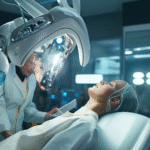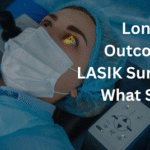Table of Contents
- What Is Toric ICL Surgery?
- Who Needs a Toric ICL?
- Toric ICL Procedure Explained
- Benefits of Toric ICL Lenses
- Risks and Considerations
- Toric ICL vs. Toric IOL in Cataract Surgery
- Conclusion
- Frequently Asked Questions
If you have been told you have astigmatism along with nearsightedness or farsightedness, you might have already explored glasses, contacts, or even LASIK. But what if your cornea is too thin for laser correction, your eyes are prone to dryness, or you simply want a reversible solution? This is where toric ICL surgery enters.
ICL, meaning Implantable Collamer Lens, gives a modern approach to correcting vision by placing a small, flexible lens inside the eye. Unlike LASIK, which reshapes the cornea, ICL works by adding an extra focusing element, like inserting a contact lens that stays in place. The toric version of ICL goes a step forward by specifically addressing astigmatism as it gives patients sharp, balanced vision.
Here, we’ll look at how toric ICL surgery works. Also, who it helps most, its benefits, risks, and how it compares with other options like toric lenses for cataract surgery.
What Is Toric ICL Surgery?
ICL surgery entails placing a specialized lens, made from a biocompatible material called Collamer, inside the eye between the iris and the natural lens. This lens helps correct common refractive errors such as nearsightedness (myopia) and farsightedness.
When someone has astigmatism, their cornea or lens is not perfectly round. This causes light to focus unevenly. A toric ICL is uniquely made. It has different powers in different meridians, tailored to correct both spherical (near or far sight) and cylindrical (astigmatism) errors.
The main difference between a standard ICL and a toric ICL is in this built-in correction for astigmatism. A regular ICL sharpens overall focus. On the other hand, a toric ICL ensures that uneven curvatures are also precisely handled, leading to crisp, distortion-free vision.
Who Needs a Toric ICL?
Toric ICL surgery is particularly helpful for people who have significant astigmatism along with myopia or hyperopia. It is usually recommended for:
- Patients with high prescriptions: Those whose glasses or contact lens powers are strong, making other treatments less predictable.
- People with thin corneas: If corneal thickness is not enough for procedures like LASIK or SMILE, ICL becomes a valuable alternative as it does not require reshaping the cornea.
- Individuals with chronic dry eyes: Laser procedures can sometimes worsen dryness. Whereas ICL surgery avoids the corneal nerves linked to tear production.
- Young adults with stable vision: In an ideal situation, candidates are over 18 years with stable prescriptions for at least one year, ensuring long-term effectiveness.
By handling refractive errors as well as astigmatism, toric ICL lenses fall within the broader field of ICL ophthalmology, which focuses on implantable lenses as a versatile solution beyond traditional laser corrections.
Toric ICL Procedure Explained
The process begins with a detailed eye examination. Your surgeon will measure your corneal shape, thickness, including the exact degree of astigmatism and refractive error. These detailed evaluations are very helpful in choosing the perfect lens power and ICL shape. Also, this makes sure it aligns well with your eye’s natural anatomy.
On the day of the procedure:
- A tiny cut is made at the edge of the cornea.
- Through this micro-opening, the folded ICL is carefully and gently inserted behind the iris.
- Once in place, it unfolds and rests in front of your natural lens.
- Special attention is paid to rotating the toric lens so its orientation precisely matches the astigmatism axis.
The entire toric ICL surgery procedure usually takes about 20 to 30 minutes per eye and is often done under local anesthesia. Thereafter, you will rest for a brief period before heading home the same day.
Post-op care includes using prescribed eye drops to aid healing and prevent infection. Follow-up visits over the next weeks and months help ensure the lens remains perfectly centered and your vision stabilizes as expected.
Benefits of Toric ICL Lenses
Patients who opt for toric ICLs usually notice a distinct difference compared to glasses, contacts, or even some corneal procedures.
- High-definition clarity: Since there is no corneal reshaping, the natural optics of the eye remain intact, leading to sharp, contrast-rich vision.
- UV protection and biocompatibility: The Collamer material naturally blocks harmful UV rays and integrates smoothly with eye tissues, minimizing irritation.
- Reversibility: If your prescription changes drastically in the future or another eye condition arises, the lens can be removed or replaced.
- Dual-action correction: By correcting the spherical power (near or far sight) along with the cylindrical component (astigmatism), toric ICL lenses give an all-inclusive solution.
Risks/Considerations
As with any eye surgery, toric ICL implantation entails some notable risks.
Cataract formation: There is quite a more chance of forming cataracts as the time passes. This is because the ICL rests close to the natural lens.
- Precise alignment needed: The toric lens must sit at the correct angle to properly correct astigmatism. If it rotates, further adjustments may be needed.
- Expense factors: Toric ICLs can be more costly than standard refractive surgeries, and not all insurance plans cover them.
- Accessibility: It is important to choose a surgeon skilled in these implants. This is because the outcomes majorly depend on meticulous pre-surgical measurements and surgical method.
A discussion about these aspects in advance helps set realistic expectations. It also ensures any minor complications are managed aptly.
Toric ICL vs. Toric IOL in Cataract Surgery
Patients at times confuse toric ICLs with toric lenses for cataract surgery. But they serve different purposes.
- Toric ICL is ideal for younger patients who still have a clear natural lens and are simply looking to correct refractive errors and astigmatism.
- Toric IOL lens is used in the cataract surgery, replacing the clouded natural lens with an artificial one that also corrects astigmatism.
So while both lenses target similar vision issues, the procedures, reasons for surgery, and long-term needs differ. Toric ICLs maintain the natural lens and are usually chosen by people seeking reversible correction before cataract age, whereas toric IOLs become relevant once cataracts impact daily life.
Conclusion
Toric ICL surgery represents an advanced, tailored option for people with notable astigmatism and refractive errors. This is especially when corneal laser procedures are not suitable. Its ability to correct both spherical and cylindrical vision problems in one procedure, while preserving the cornea’s natural structure, makes it a standout choice.
If you have been told you are not an ideal candidate for LASIK or simply want a reversible solution that offers long-term clarity, speaking with an experienced refractive surgeon can help determine if toric ICL is right for you.





